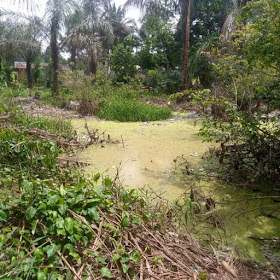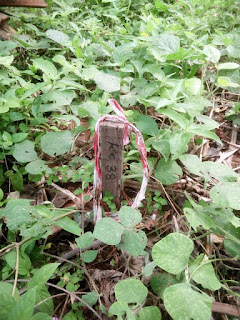Priscilla Akpanettot
All is not well with Afia Nsit, a quiet settlement in Nsit Ibom Local Government Area where the drainage collecting flood water from Ikot Oku Ikono Flyover is situated. The community which has become a victim of the Flyover project has counted more than a thousand losses ranging from lives to properties since the construction of the drainage.
Anyone passing or driving through the recently constructed Flyover of the Governor Udom Emmanuel’s administration will simply appreciate the aesthetics of its construction and applaud the initiative to ease vehicular traffic around the area, without knowing what turbulent troubles the host communities are going through.
 |
| Endpoint of the drainage |
From the East of the Flyover to the West, North and South; sad tales abound of how the much-talked-about Flyover has become a nightmare to the host communities, particularly Afia Nsit which houses the drainage conveying the flood water gathered by the Flyover.
The drainage which is a mega wide opening on the right side of the untarred access road leading to the community from the Flyover is not only wide but deep and stretches into the depth of the village. Moreso, it is open and unguarded, without any form of illumination to forestall accidents at night.
 |
| A sight of the flood effect |
When it rains, the flood waters from Abak, Idoro, Etinan and Ikot Oku Ikono road which all gather under the Flyover, are poured into the drainage, to meet the flood water from Arc. Nyaetok’s Novone Estate, Godswill Obot Akpabio International Stadium and its environs before invading the community. So heavy is the force and volume of the water that it overfills the drainage within minutes and pours out on the community, making the untarred muddy road slippery and impassable. At the point of being filled, the uncovered drainage becomes invisible and a threat to members of the community who must cross the flood-covered drainage to get to and out of their homes.
Consequently, a number of valuables including two people have been drowned in the killer water. The situation is even more terrible for Pupils of St. Stephen African Church School, a government-managed School with its entrance at the wide-mouthed drainage.
Also, the surrounding farmlands have been in ruins since the Flyover was constructed as all the residues of the flood including plastics, rubber, carcasses of animals and all sort of wastes are emptied on the entire land mass of the community, making it a permanent dump site.
As a result, the stench of the decomposing wastes have made life in the hitherto ecofriendly community unbearable, coupled with its accompanying health hazards of being a breeding ground for well-fed mosquitoes.
 |
| A decomposing body was found here a year ago |
Upon enquiry, the Village Head of Afia Nsit, Obong E. E. Akpan bitterly lamented the ugly significance of the Flyover and its attendant effect on members of the community. His responses to questions asked further blew the mind of this reporter.
“If it rains now, you can’t enter this place. Nobody comes around here when it rains to avoid being carried away and it will take up to four days for the waters to recede”.
 |
| The dead River which once served the domestic needs of the community |
“The only edible water (river) we used to have has been filled up by the sand accompanying the flood so we neither have water to drink nor road to our houses. We buy water from the only borehole around and enter our homes from Mbak Nsit, the next community”.
“This was where they were meant to stop this drainage (pointing towards Usak River). The drainage was meant to be a 2.5 Kilometer construction, leading to Usak River which will take the flood water to Mbiokporo River but they stopped at 1.7 Kilometer because they saw this swamp (Ekaiso).
 |
| The other part of the community geographically divided by the flood is now accessed by this 'bridge' |
“This is not a normal swamp because we used to drink from it and use it for other domestic purposes. It was very neat and clean. We asked them to channel the water here so that the flood can move straight to Mbiokporo River but they saw this swamp and the river down there (Idim Mbed) and decided to channel the flood there.
“This whole place has become ravineous and our community has been geographically divided by the flood”, he said.
 |
| Julius Berger's marking, indicating the end point of the drainage |
 |
| Their numbers were written on this tree's trunk |
When contacted to confirm the Village Head’s report, the constructing firm, Julius Berger became very hostile and aggressive, and demanded an official letter before obliging any information. They however referred this Reporter to the Ministry of Works.
At the Ministry of Works, the Supervising Engineer refused to respond to questions on the construction without the permission of his Boss, the Commissioner. A staff of the Ministry however insisted that “the length of the flood control project is 2.2km with an access road” and had been duly constructed and delivered to the community.
 |
| The Primary School facing the drainage |
After submitting the letter to Julius Berger, the construction firm is yet to respond, despite four visits to their office at Itam Industrial Layout.
The Community wants the drainage area properly channeled to the agreed point; covered and lighted at night to avoid accidents. They also have a need for water and protection from the hazards of the stagnated flood water. They are therefore calling on the government to act responsively to their plights in time to avert further damages to lives and properties.
See videos of interviews with members of the community on:
https://m.facebook.com/story.php?story_fbid=pfbid02yJpAG3tafoG9af2EWeuRsdMPrRLc5VzaMKuEeVPrsFkYBjMDMJvvKCXguUCvJ1bsl&id=100008020651077&mibextid=9R9pXO



No comments:
Post a Comment